Blues Reviews Feb/March 2016
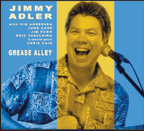 Jimmy
Adler
Jimmy
Adler
Grease Alley
Sprucewood Records
Recorded at Kid Anderson’s Grease Alley studio, with Kid Anderson
twisting the knobs and playing both electric and standup bass, guitarist/vocalist
Jimmy Adler has a rip-roaring disc on his hands. The fellas on the date
are first-rate players, as well: drummer June Core, keyboardist Jim Pugh,
and tenor saxophonist Eric Spaulding are joined by guest vocalist and
guitarist Chris Cain on a couple of songs. This 13-tune collection is
100% original, although nods to heroes are conspicuous throughout. The
opener, for instance, Play It Like Magic Sam, has Chicago written all
over it, as you might expect. What you may not be ready for is Jimmy Adler.
He’s adept on a jazzy groove like the opener on which he sings,
“I’m not one for chit chat/my phone bill’s too much/I
don’t send out postcards to keep in touch/I’m a guitar man/that’s
what I am/try to tell it like T-Bone/say it like Magic Sam.” The
single guitar notes cascade with impressive authority and the band is
superb in their backing. On the title cut, played appropriately greasy-like,
Adler and the fellas explore a New Orleans funk groove. He quotes When
the Saints Go Marching In and Core lays down funky second line percussion.
Drank Too Much showcases his impressive slide work and explores a familiar
theme for some folks: “When I woke up this morning/had to drag myself
out of bed/Put on a pot of coffee to clear my whiskey head/I drank too
much.”
No Pain is a bluesy salute to serious drinking, or is it a tribute to
John Lee Hooker? Jimmy shares the mic stand with the great Chris Cain
singing, “The older I get seem like the less that I know …
my doctor’s got me on a prescription/He give me milk, cream and
alcohol/that’s why that’s why that’s why/I don’t
feel no pain at all.” Adler’s guitar work is sharp and concise,
the epitome of electric guitar blues. Nine Behind is a nod to Albert Collins
reminding of Master Card. Jim Pugh turns in a superb piano. I Can’t
Wait is a west coast swinging affair. “You’ll be smiling when
we’re through/can’t wait to get my hands on you.” The
saxophone is sexy here. Cornbread and Lima Beans is more of the same,
“Corn bread and lima beans/fried chicken and collard greens/way
down south where the music’s from.” Cordelia showcases more
of Adler’s jazzy chops (“put down your dress Cordelia/they
already had last call.”). The guitar and sax unison lines are a
treat. What Will You Do again features Chris Cain, though this time on
guitar. Adler sings “I been suffering in silence for too long.”
Pugh has a nice upright piano section that defines ‘tickling the
ivories.’ The closer, Hoodoo Highway, with its Mojo Working riff,
is a tribute to Muddy Waters. Honky tonk, bar walkin’ saxophone
shares space with Adler’s twangy guitar. Good stuff made for plenty
pf volume. You’re right, Robert Jr., he is hot stuff!—Mark
E. Gallo
 Fiona
Boyes
Fiona
Boyes
Box & Dice
Reference Recordings
Ever since she won the solo acoustic category in the International Blues
Challenge of 2003 (the first woman and the first Australian to do so)
Fiona Boyes has been as unstoppable as a wild fire. She’s won more
awards and accolades than you can shake a guitar at and she gathers more
fans with each new release. The release at hand will likely bring even
more into the fray. A master of multiple styles – from Piedmont
finger picking to prewar Delta to Chicago and back, she brings classic
songwriting, and powerful, muscular vocals to a repertoire that stretches
back to the 1920s. For this 13th release she steps into a new realm of
playing with the cigar box guitar, or, as she described it in the liners,
“a little junk yard dog of a guitar.” She plays it here, along
with a one-of-a-kind National Reso-lectric Baritone, her Maton Mastersound
electric, and a four string box guitar acquired just before the recordings
began.
Outside of three wonderful covers, these are all new and original songs
meant to showcase her talents on each guitar. That talent is abundant
in this collection. Boyes is a maestro who writes clever material, plays
the heck out of the guitar and has an attention-getting rough vocal prowess
that captivates. The opener, Juke Joint on Moses Lane, about a Tallahassee
club (Bradfordville Blues Club), grabs the ears with authority. She sings,
“Outside they’re frying catfish/inside they’re raising
cane.” Stunning guitar with a sparse drum. Walking Round Money has
an equally minimalist groove, although groove is the operative word. This
is the kind of song you shake and twist in your chair to (“I got
my walkin round money and I feel alright.”). Her version of Smokestack
Lightning is as good as any I’ve heard down to the howl. Guitar,
again, is spectacular. It’s a given that the guitar playing will
never be less than awesome. Boyes is about telling the story – whether
lyrically or with her guitar. On Mama’s Sanctified Amp her slide
work is unparalleled. “Mama don’t allow no devil’s music/mama’s
amp was sanctified.” Walk With Me (“times of trial be my friend”)
is a tender ballad that mesmerizes with its sweetness. Tiny Pinch of Sin
features fantastic slide work and opines that “Life is full of blessings
and a tiny pinch of sin.” This is a fun one. The closer is Magic
Sam’s Easy Baby and it’s a tour de force of wicked good guitar
straight out of the legend’s play book, with that classic echo.
As a fan I can say that this may well be the best thing she’s ever
recorded. It sure works for these ears. —Mark E. Gallo
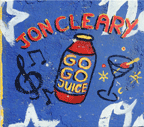 Jon
Cleary
Jon
Cleary
GoGo Juice
FHQ Records www.johcleary.com
Jon Cleary may have been born in England but his heart and soul resides
deep in New Orleans and his newest recording of all original music, “Go
Go Juice,” typifies this with a universal funk that may be the new
sound of Rhythm and Blues. Recorded with a Louisiana crew including Derwin
Perkins and Shane Theriot on guitars, bassist Calvin Turner, drummer Terence
Higgins, Nigel Hall on keyboard and a horn section including Eric Bloom
trumpet, Ryan Zoidis saxophone and Charles Haloran trombone and with the
late Allen Toussaint fulfilling the Big Easy sound writing horn charts
to get this real gone.
Ringing in with rim shots, grooving horns and easy swinging vocals “Pump
It Up” bounces along slowing for a chorus then pumping again till
an angular guitar winds into a second line drum number with the Dirty
Dozen horns taking it to the “Boneyard” and back to guitar
as a heartbeat organ fades to the finish. Shifting from the funk to a
deceptively upbeat piano ballad Jon gently pleads “Brother I’m
Hungry” for those unfortunates asking for a hand up from those cold
streets, bringing a tear as you realize the true gravity of his song.
Keeping the funk in the street “Getcha GoGo Juice” Jon says
it’s “comprised entirely of lines I’ve overheard people
say in New Orleans.” A Jr Walker-styled horn ushers in the vocals
of “Beg Steal or Borrow” a funky piano underpinning the backup
vocals and the horns leading out. A gentle vocal and piano with sparse
ringing slide “Step Into My Life” has a surging undercurrent
of bass pulling it forward to the full band. After Katrina, many musicians
were set adrift, Cleary sings “Bringing Back the Home” from
the heart as the music surges into a chorus of “jazz, funk, rhythm
& blues and soul” creating a hymn-like quality, with Ivan Neville
and others getting into the flow and true heartbeat of the city. Slipping
into a gentle swing for “9-5,” that gig for some people can
feel like doing nine to ninety-nine as their lives slip away while their
remote control takes them deeper into that harsh sentence. The finale
“Love On One Condition” sums up the easy funk that pervades
this disc.
Though Jon Cleary may speak with an English accent, the spirit of his
adopted city has sculpted the essence of “GoGo Juice,” it’s
100% New Orleans. —Roger & Margaret White
 Westside
Andy
Westside
Andy
Blues Just Happen
Earrelevant Records www.westsideandy.com
Westside Andy may be slight in stature but he’s huge in heart; when
I complimented him on a harp solo he told me “it all comes from
the heart” and that’s right where he hits you. Andy is regarded
so highly that Dan Aykroyd wrote the liner notes saying, “Blues
Just Happen” “is one of the tightest, perfectly true to the
American Blues form to arrive in years....the new standard for aspiring
and even veteran electric amplified harmonica players.” The title
of Andy Linderman’s newest CD “Blues Just Happen,” typifies
his modesty, it didn’t just happen, he’s developed his style,
crafting his skills playing thousands of gigs over decades on the road.
Currently touring with Reverend Raven and the Chain Smoking Altar Boys,
for this endeavor Andy has enlisted the assistance of old friends and
ace Chicago players Barrelhouse Chuck on keys, Billy Flynn on guitar with
a rhythm section of Dave Wood and Steve Dougherty. Then, playing live
at the Armory in Janesville, Wisconsin, Andy let these blues happen.
The disc kicks with a tight set of classics that allows everyone to get
loose with Little Walter’s “Just Keep Loving Her” and
a moody “Sad Hours.” Chuck and Flynn underscore Andy’s
full throated authority on Muddy’s “Mean Disposition”
as the interplay of slide, harp and piano recreate that classic Chicago
sound. Jumping with a lighter tone, John Lee Hooker’s “My
Daddy Was A Jockey” takes a joyful leap as the harp truly takes
flight before bringing it back down to earth with Smokey Smothers’
“Got My Eyes On You” with Andy’s harp piercing the tension
as Chuck’s vintage Farfisa organ stings. Billy Flynn steps up with
his own “Liquor Store Blues” as a wobbly harp and stumbling
piano lead to Andy’s high head solo before Chuck goes flying into
a raucous “Lonesome” from Memphis Slim and Andy’s harp
echoes Barrelhouse’s final flight of boogie. Westside also penned
two original instrumentals, the first simply called “Just Cuz,”
an easy rolling stroll that continues the interplay between piano and
harp before charging into Detroit Jr’s “Call My Job”
with guitar and piano leads swerving onto the “Killing Floor.”
From there Andy leads an elegant instrumental cover of Wilson Pickett’s
hit “Don’t Let The Green Grass Fool You” then signals
the end of the set with a get ‘em to their feet original “Over
& Out.”
Westside Andy’s “Blues Just Happen” is a generous slice
of real Chicago blues with heartful soul.—Roger & Margaret White
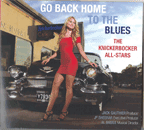 The
Knickerbocker All-Stars
The
Knickerbocker All-Stars
Go Back Home to the Blues
JP Cadillac Records 2015
In autumn 2014 I reviewed the debut release by the Knickerbocker All-Stars,
and proclaimed it one of the best albums of the year. The good news: this
sophomore effort is equally as good, one of the best albums of 2015.
The core group of this Rhode Island ensemble remains essentially intact,
but there have been a few changes. Instead of a roster of eight rotating
singers, the list has been reduced to four. Guitarist Ricky King Russell
has been replaced by Monster Mike Welch, who acquits himself splendidly.
The piano chair is now exclusively the province of Al Copley due to the
sad demise of keyboard maven Dave Maxwell. Also playing a more prominent
role is Al Basile, who plays cornet on one track and composed four of
the thirteen songs.
Most of these musicians have known each other for years, and the group
is basically an amalgam of past and current members of Roomful of Blues,
the Duke Robillard Band, and Sugar Ray (Norcia) and the Bluetones. Their
rapport is seamless.
The selection of tunes is likewise top-notch. The prevailing motif is
horn-driven jump blues, exemplified by covers of Fontaine Brown’s
“Cadillac Baby” and Chuck Willis’ “Take It Like
a Man.” When those tunes kick in, your brain may advise, Stay dignified,
but your feet will declare unequivocally, Get up and dance! There are
two instrumentals: “Hokin’ “ is anchored by Copley’s
piano and features a “battle” between the three saxophones…without
a loser! “Blockbuster Boogie” again showcases Copley, as well
as Doc Chanonhouse with an impressive trumpet solo.
Welch is given limited room to display his chops, but makes the most of
it. His intro solo on “Annie Get Your Thing On” invokes Albert
King in a track which intriguingly changes tempo twice; the tempo change
recurs in “He Was a Friend of Mine,” which begins as a gritty
Chicago blues, segues to some smooth soulful crooning, and closes back
in the Windy City.
Finally, enough can’t be said about the vocalists. Sugar Ray, of
course, has established his credentials over many years and many albums,
but Brain Templeton and Willie J Laws (and Basile on one cut) are equally
and dazzlingly good.
Can’t wait for this group’s next effort!— Steve Daniels
 Nikki
James
Nikki
James
The Album
Fat Girl Records
Nikki James is a Detroit treasure. An unabashed music fan and booster,
serving on the board of the Detroit Blues Society and performing with
her crackerjack band at the drop of a hat, she’s also an organizer
of sundry events and jams. Between her first disc in 1999 and The Album
were a few years when her fans spoke of her career in the past tense.
She was diagnosed with a node on her vocal cords from overuse. “In
1998 I had a node removed from my vocal cords. Dr. said quit singing until
it shrinks or have it removed. Well like most professional musicians I
needed to work so I opted to have it removed and took a few months off
versus years.” Her appearances were few and far between for a bit.
She hit the stages will a vengeance about a year ago. The disc at hand
speaks to the renewed energy that she brings.
With the able assistance of some of the baddest guitar players in Detroit
– Jim McCarty (Mitch Ryder and the Detroit Wheels and Cactus fame),
Josh Ford, Robert Noll (ex-Albert Collins), Brett Lucas (Bettye LaVette)
and Dave Mazzara – and rock steady rhythm masters Todd Glass or
Ron Pangborn on drums, Alex Lyon on bass, James Wailin (harp), and keyboardists
Phil Hale and Jimmy ‘Blues’ David, Nikki has surrounded herself
with top notch talent. The main event is clearly the singer, though. This
singer has pipes to spare and she doesn’t hold back anywhere on
this all-original set. Opening with Just When You Think she makes it abundantly
clear why she’s one of the most respected and admired singers in
town. “Just when you think you got all figured out/Just when you
think you know what you’re talking about” everything changes.
She gives the players room to stretch and McCarty shreds while Glass beats
the drums mightily. I’m Your Child is a rockin’ testimony
to her faith replete with fiery harp and showcases her quiet side.
Still Burnin’ (Motor City Race Fires) speaks to the 1967 riots in
Detroit, the week that she was born. McCarty’s guitar work replicates
the chaos that was the city complexion at the time and James sings of
1967, 1997 and 2007 and on and on in the same breath. Nothing has changed.
Lyrically the strongest song on the disc, Nikki James sings of her mother
disapproving of her liking “that fine black boy down on the corner,”
telling her to “stick with your own kind.” The fires are still
burning. The gospel-inflected Thornetta Davis’ backing vocal adds
to the power. On I Got the Blues she sings, “It’s three o’clock
in the morning/I sit here and wait/20 days out of 30 my baby’s been
home late/you been shining up your walkin shoes and I got the blues.”
The energy is high. In addition to Koko Taylor, James calls Paul Rogers
her most important musical influence. She rocks like a woman with more
than a little of that rock and roll in her soul.
On Mama Learned to Boogie she gobbles the mic while Noll rocks and Glass
keeps the beat heavy. She sings, “Since she been gone/things just
ain’t the same” and the band breaks into a Savoy Brown shuffle
and sparks fly. She adds an almost country wisp to the beautiful Please
Don’t Walk Away, and I’m Watching You takes it back to the
heavy groove. “Most of the time things went fine/seemed fine to
me/Went out on a weekend with the girls/got stoned and watched TV.”
Brett Lucas provides the burning guitar. On I Found Love Josh Ford takes
the funky lead guitar role while Nikki sings over Hale’s organ.
“I love you good mister/love you right mister/love you long.”
This is grease Detroit style. The closing I Don’t Want to Leave
You speaks to the confliction of emotions. She sings, “Call me crazy/call
me fool/I’d be a lost and lonely woman if I never had you.”
The package is brilliant, from Nikki’s powerful and expressive vocals
to the fiery instrumentation to the cover art. First class. Highly recommended.—Mark
E. Gallo
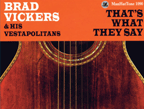 Brad
Vickers & His Vestipolitans
Brad
Vickers & His Vestipolitans
That’s What They Say
Man Hat Tone
Brad Vickers has been mining the old timey, rags and classic blues field
for years. He cut his musical teeth with the likes of Pinetop Perkins,
Sleepy LaBeef and Hubert Sumlin before taking it on the road and into
the studio under his own name. This is his fifth recording and it’s
perhaps the most enjoyable. In addition to Vickers’ guitar and vocals,
Margey Peters is on bass, fiddle, and backing vocals, and Bill Rankin
plays drums. Matt Cowan (baritone sax), and Jim Davis (clarinet) add the
right amount of swing. Dave Gross plays upright and electric bass, mandolin,
and banjo here and there, Charles Burnham plays fiddle here and there,
and Mikey Junior adds backing vocals.
There is so much to recommend this brilliant collection, starting with
the opening Tampa Red-penned Seminole Blues (“she left this morning
on that Seminole/I got the blues so bad it hurts my tongue to talk/I’d
follow my baby but it hurts my feet to walk”), performed by the
trio of Vickers on bottleneck and vocals, Peters on bass and Rankin on
drums. The following Don’t You Love Your Daddy No More, with sweet
clarinet filigrees and bottleneck, harkens back to that same era but with
added jazz influence. Credited as traditional and learned from Leadbelly
it’s a fine representative of what is to follow. Classic American
music written by either Vickers or Peters, but sounding like it was written
decades ago.
Vickers mines a lot of stylistic territory here. If You Leave Me Now is
fiddle and percussion driven and Everything About You Is Blue is a folk-blues,
again enhanced by Charles Burnham’s violin. Another Lonesome Road
is lyrically and musically fun. You’ve heard a few dozen songs about
that famed lonesome road. Here, Vickers laments “why am I goin’
down another lonesome road/can anybody tell me/does anybody know?”
The title cut (“a jackass without his Janey mule/He’s not
an ass/he’s just a fool”) is a medium tempo blues smile-inducer.
Mountain Sparrow is an Appalachian style fiddle tune. Margey Peters’
Fightin’ is an acapella (with backing vocals and percussion) take
on the age old subject of wars, or more specifically wars fought over
religious beliefs. Fighting in the name of the Lord — whichever
Lord you subscribe to. The following Don’t You Change a Thing lightens
the mood with a driving guitar and fiddle romp. Mama’s Cookin’
opens with a cymbal one, one-and-two, one-and-two rhythm and is enhanced
by horns. Margey sings about “lasagna, ravioli, meatballs and ziti.
Eggplant parmigiana and a little cabanini.” and says “isn’t
it great to be Italian?” Twenty-first Century Rag is just that.
On it Vickers and Peters sing, “We used to go to a movie/now a movie
comes to us….new times are coming our way/old ways are fading away.”
The times they are a changin’. Margey Peters’ fiddle is outstanding.
The Secret is a rocker of sorts and Having A Ball is a rockabilly-flavored
number that features Dave Gross on electric bass and piano. The closer,
In For A Penny, is what he refers to as “gypsy-tinged.” On
it, Peters is joined by Christine Santelli and Gina Sicilia. The vocals
dominate. The guitar and percussion support. Brad and the band don’t
fail to delight.—Mark E. Gallo
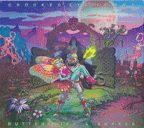 Crooked
Eye Tommy
Crooked
Eye Tommy
Butterflies & Snakes
Self-produced 2015
Over the last several years guitarist/vocalist Tommy Marsh and his band
have established themselves as a veritable blues institution in their
home of Ventura, CA, and the surrounding area. In addition to playing
festivals and multiple gigs throughout California, the group hosts a weekly
blues jam session in Ventura, generously plays benefits, and also represented
the Santa Barbara Blues Society at the 2014 International Blues Challenge
with considerable success.
The ensemble is comprised of Tommy on lead guitar and vocals, his brother
Paddy on guitar and vocals, Glade Rasmussen on bass, Tony Cicero on drums,
and renowned regional multi-instrumentalist Jim Calire on saxophone and
keyboards.
A few others musicians augment selected tunes adeptly. Their debut album
is an indisputable winner.
Perhaps most impressive is the quality of the eleven songs, all of them
originals penned by one of the Marsh brothers. There is not a clunker
in the bunch, and I predict that other artists will soon be clamoring
to cover them. The album opens with the eponymously named “Crooked
Eye Tommy,” a compelling tune synopsizing Tommy’s background.
“Come on In” displays a greasy guitar intro followed by the
two Marshes nice guitar interplay, followed by one of my favorites of
the outing, “I Stole the Blues,” wherein the band name-checks
Muddy Waters, Albert King, Johnny Winter, and T-Bone Walker as members
of the pantheon of blues heroes that it has proudly stolen [learned] from.
“Time Will Tell” gives Calire room to vamp on organ, as does
guest Bill Bilhou on “Tide Pool,” the ethereal next number,
abetted by background harmonies.
The album really hits its apex with “Love Divine” and “After
the Burn”; the former, reminiscent of the best of Robert Cray or
Ronnie Earl, has syncopated guitar interplay and an inspired and inspiring
vocal; the latter is a finger-popping, danceable track with an undertone
of reggae.
That ain’t all! “Over and Over” is a slow seven minute
love ballad with a beautiful saxophone contribution by Calire, and the
album closes with “Southern Heart” - you guessed it - a mid-tempo
tune proving that the band can play quality country music, too.
Tommy Marsh’s guitar leads are splendid throughout, moving without
being showy or frenetic, and his tenor vocals are equally excellent. I’m
lucky because these guys live near me and I can see them when I want to;
if you can’t, you can enjoy this top-notch release instead.—
Steve Daniels
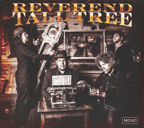 Reverend
Tall Tree
Reverend
Tall Tree
Reverend Tall Tree
Yards Records 2015
Consensus holds that blues music evolved from progenitors in west Africa,
and was transmuted into the music we know and love via field hollers,
work songs and early gospel expressions. Innumerable seminal blues artists
moved from the religious to the secular (and some back again); think Reverend
Gary Davis among others. In the contemporary blues world several artists
invoke the tradition, whether or not they are or ever were actually clergy.
Reverends Raven, Shawn Amos, and Billy Wirtz immediately come to mind.
Whether their religion is Christianity or the blues or both, they are
devout.
Joining the roster is Reverend Tall Tree, a moniker adopted by Southern
California bluesman Chris Pierce. His debut album presents him front and
center of a quartet comprised of Ol’t Parker on guitar and keyboards,
Doctor Cooper on bass, and Professor Lovejoy on drums. (We’re not
told if these are aspirational advanced degrees or actually belong to
professionals.) Big Mono sits in on six of the ten tracks, playing various
instruments.
Fittingly, the eponymously named album spotlights the Reverend’s
vocal on every cut. Song selection features three originals, and the rest
are covers of tunes by such luminaries as Willie Dixon, Big Walter Jacobs,
Amos Milburn, and even Bob Dylan.
What we get is an interesting amalgam of grit, soul, and a bit of crooning.
The opening cut, “Light My Candle,” with its suggestive lyric,
segues into a cover of Dixon’s “Mellow Down Easy,” distinguished
by nicely syncopated bass and drums. The brief shuffle “Railroad
Line” is followed by “Boom Boom Baby,” a Tall Tree original
evoking memories of Little Richard in his prime. “How Do You Get
Over That,” another original, allows Tall Tree to display his soul
chops to good effect.
“Tell Me Mama” is an uptempo rockin’ blues, leading
into Dixon’s “Pretty Thing,” a vehicle for Tall Tree
to show his vocal range. The rev. then tackles Dylan’s “Everything
Is Broken” with a histrionic vocal, but ends smoothly with the aptly
reverential “Everlasting Light.”
Parker’s guitar support, distorted and greasy in a Mississippi hill
country style, is generally appropriate (check out Milburn’s “Bad
Bad Whiskey”), although somewhat jarring in “How Do You Get
Over That.” Tall Tree himself pitches in on harmonica on several
cuts, with varying success. Over-all, the CD presents a variety of blues
from a promising talent.— Steve Daniels
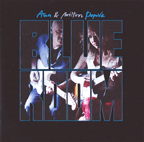 Ana
& Milton Popovic
Ana
& Milton Popovic
Blue Room
ArtisteXclusive Records 2015
She may look about eighteen, but Ana Popovic has been playing the blues
for over twenty years. Exposed to the blues by her guitar-playing father
in their home in Belgrade (in then-Yugoslavia, now Serbia), she fell in
love with the music, picked up her father’s guitar at age fifteen,
and hasn’t looked back. Her first album was released in 1998, and
since then she has produced several more highly lauded albums and established
a successful career in Europe and the U.S. Now ensconced in Memphis, she
allegedly plied all her wiles for ten years to convince her reluctant
father to finally to collaborate on an album.
Supposedly dad chose the sturdy supporting crew, comprised of Rick Steff
on keyboards, Dave Smith on bass, and Steve Potts on drums. Together Ana
and Milton selected eleven quality songs to cover. Maven that she is,
Ana takes the guitar leads, but Milton lends solid rhythm backing, and
they share vocals adeptly. Their harmonizing is especially appealing,
and suggests that they have indeed been singing together for years.
The set begins with the brief “Catfish Blues” by Robert Petway,
with Ana purveying nice acoustic slide. Milton carries most of the vocal
load on John Lennon’s “I’m Losing You,” and the
two trade guitar solos on the beautiful “Evening Shadows,”
a number stimulating memories of 1970s Fleetwood Mac. On “Grant
Spivey,” an ode to Victoria Spivey’s own father, Ana goes
it alone, followed by the heavy rocker “Somebody,” handled
by Milton with vocal aplomb.
Two slow tempo Tony Joe White tracks ensue, and for me they are highlights.
“Did Somebody Make a Fool Out of You” presents some delicious
guitar interplay between the principals, and “Rainy Night in Georgia”
is equally moving despite a somewhat incongruous frenetic mid-song six-string
foray by Ana. The set puts some rock into “Red River Blues”
by Sonny Terry and Brownie McGhee and “Baby What’s Wrong”
by Jimmy Reed, the former tune distinguished by Steff’s fine piano
work, and the CD closes with a slow rendition of John Lee Hooker’s
“Tupelo,” which Milton fashions into a spooky talking blues
abetted by Ana’s acoustic slide.
Speaking of which - Ana is a whiz on guitar, but it’s no surprise
that she has participated in multiple Jimi Hendrix tribute tours: she
loves that wah-wah pedal and furious strings of notes. She’s damned
good at it, too, but when she slows down and plays emotionally, she is
sublime.—Steve Daniels
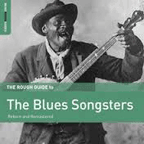
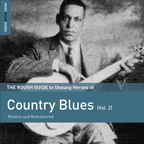 The
Blues Songsters
The
Blues Songsters
Various Artists
Rough Guide RGNET1343CD World Music Network
Unsung Heroes Of Country Blues Vol. 2
Various Artists
Rough Guide RGNET1344CD World Music Network
The songster tradition, both anticipating and co-existing with blues music,
began shortly after the end of slavery and the Reconstruction era as African-American
musicians were able to travel and play music for a living—with black
and white performers alike sharing the same repertoire, chiefly an extensive
assortment of folk songs, spirituals, ballads, dance tunes, minstrel ditties
and rags and reels. Along with a number of musicians shrouded in mystery
and scarcely recorded—Lonnie Coleman, Will Bennett, Dick Justice
and Hambone Willie Newbern, for instance, along with Louie Laskey—who
asks the eternal question “How You Want Your Rollin’ Done?”—this
24 track, superb sounding Songster compilation also boasts numbers by
legends on the order of Leadbelly, Charley Patton, Mississippi John Hurt,
Blind Blake, Furry Lewis, Frank Stokes and a host of others. How can you
go wrong with a collection that includes the illustrious Stovepipe No.
1 & his buddy David Crockett singing “A Chicken Can Waltz The
Gravy Around.”? Similar to the first volume in Rough Guide’s
“Unsung Heroes” series, this follow-up CD (also with a generous
24 tracks) is, likewise, full of surprises and hidden nuggets and serves
as a refreshing overview of the regionally varied forms of the country
blues idiom. The laid-back East Coast branch is particularly well represented
by a trio of guitar virtuosos—Willie Walker (who Josh White touted
as the best string-snapper he ever heard), the singing barber William
Moore (who in between haircuts cut a raft of sides for Paramount) and
the illustrious Barbecue Bob’s brother, Charley Lincoln, with his
cautionary “Mama Don’t Rush Me.” The more intense, emotionally
arresting Delta Blues offshoot includes well-chosen sides by Kid Bailey,
slide-guitar whiz Sylvester Weaver (who recorded the first blues instrumental,
“Guitar Rag”) and Ishman Bracey, with his profoundly chilling
“Woman Woman Blues.” Incidentally, Bailey and Bracey were
part of a group of blues legends that included the venerable Son House
and Tommy Johnson. Other favorites encompass Delta blues diva Mattie Delaney
(with an energetic redo of Tommy Johnson’s “Big Road Blues”),
exalted minstrel show harmonica ace Jaybird Coleman (a witty “Man
Trouble Blues”) with things winding down to an apropos conclusion
courtesy of Little Hat Jones’ signature song “Bye Bye Baby
Blues.” Both well worth hunting down along with Rough Guide’s
first volume of Unsung Heroes and an entire CD devoted to the extremely
popular Barbecue Bob. —Gary von Tersch
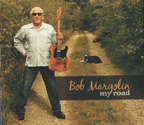 Bob
Margolin
Bob
Margolin
My Road
Steady Rollin’ Records/VizzTone 2016
Initially inspired by seminal rock-and-roller Chuck Berry, Bob Margolin
was playing in bands by his late teens. His talent was appreciated by
none other than Muddy Waters, in whose band Margolin played from 1973
until he left to form his own group in 1980. Since then he has garnered
multiple plaudits and awards, released many albums and diversified: one
of his recent albums, in 2012, was a duo effort with the late pianist
and singer Ann Rabson.
His brand new release features Margolin accompanied only by drummer Chuck
Cotton and harmonica player and rhythm guitarist Tad Walters as they explore
a dozen eclectic tunes. Don’t expect twelve or even two Chicago
blues numbers. Margolin composed seven of the tunes, which are alternately
introspective, nostalgic, and regretful. In addition, there are nice covers
of songs by Nappy Brown and Sean Costello, among others.
Those who have been following Margolin’s career know that he has
become a skilled author and music columnist as well as musician, and so
the trenchant and moving lyrics of his songs are no surprise. “I
Shall Prevail” is a fierce assertion of will in the face of adversity,
as the singer proclaims that “I used to run through the world, but
now I have to climb.” “Young and Old Blues” is a simultaneously
humorous and rueful observation on aging, and “Understanding Heart”
a poignant plea for compassion and understanding.
The set is bookended by two of its best tunes. The opener, “My Whole
Life,” reprises Margolin’s career as a musician - “Blues
has been my teacher for everything I’ve learned” - accompanied
by his greasy guitar licks and nice interplay with Walters’ harmonica.
The long closing piece, “Heaven Mississippi,” is a slow, almost-talking
blues that name-checks Muddy, Robert Johnson, Koko Taylor, Junior Wells
and a slew of other blues greats who have etched their music and characters
into Bob’s persona.
Chuck Cotton provides exemplary rhythmic support throughout, and he and
Margolin harmonize vocally on Nappy Brown’s “Bye Bye Baby”
with only Walters’ harp accompaniment. On “Young and Old Blues”
Walters and Margolin mesh their guitar offerings splendidly. Several other
cuts highlight Margolin expertly intertwining with his own overdubs on
guitar and bass. As a guitarist, Bob displays his prowess and creativity
with consistently inventive combinations of chords and single notes. Oh,
yeah, don’t lament the absence of Chicago blues: “Feelin’
Right Tonight” has it covered.— Steve Daniels
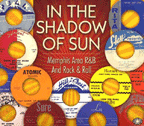 In
The Shadow Of Sun:
In
The Shadow Of Sun:
Memphis Area R&B And Rock & Roll
Fantastic Voyage FVTD-200 www.fantasticvoyagemusic.com
With its commanding position overlooking one of the world’s major
rivers and its strategic location at the crossroads of the mid-South,
with Mississippi to the immediate south and Arkansas to the immediate
west, Memphis was often the first stop for musicians of all stripes from
the rural Mississippi Delta, looking for work and on their way to the
industrial North. By the early 1950s, its population had soared to nearly
half a million and the time was ripe for a plethora of homegrown independent
labels, often shoestring operations, to cater to the local jukeboxes and
emerging radio stations and, in effect, also act as an outlet for the
area’s semi-professional (yet often very talented) artists who were
doing fine without making the often arduous journey up to Nashville, Chicago,
St Louis or Detroit to record. The very accurately titled In The Shadow
Of Sun, compiled and annotated by the knowledgeable Dave Penny, collects
101 raw-sounding, often blues-accented rockabilly/hillbilly/rock ‘n’
roll-oriented tracks released on independent labels in Memphis (or nearby)
that followed in the wake of the runaway success of Elvis Presley and
Sam Phillips’ Sun Records in the mid-1950s. Early participants in
the indies stakes include James Mattis’ optimistically titled Starmaker
label (that folded after only three releases) while a pair of California
concerns, Ekko and Modern, established their own Memphis-based imprints—the
latter created the Meteor label and recorded the likes of Joe Hill Louis
and Little Milton. Soon thereafter came OJ, Von (based just over the state
line in Mississippi), House of Sound, Jaxon, Atomic, Lu, Sure, Hornet,
Moon, Sky (another Mississippi-based imprint), Erwin, Kay, Crystal, House
of Sound (actually on Beale Street), Kim, Blues Boy Kingdom (owned by
B.B. King), Stomper Time, Katche, Skipper, Rita, Benton and the still
thriving Ardent label—responsible for unleashing Alex Chilton and
Big Star on the world. If most of these labels are unfamiliar, it’s
no surprise that with scant exceptions, like the fore-mentioned Joe Hill
Louis and Little Milton and Roosevelt Sykes, Carl Mann (with Carl Perkins),
Wink “Deck Of Cards” Martindale, Willie Mitchell, Fenton Robinson
and Johnny Burnette, the artists are equally enigmatic which is exactly
why their few, often ill-distributed recordings have been revered by ensuing
generations of hep collectors. It’s great to have an abundance of
them in one place. Play loud! —Gary von Tersch
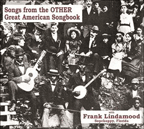 Frank
Lindamood
Frank
Lindamood
Songs From The OTHER Great American Songbook
Good Track Records
www.franklinlindamood.com
Floridian Frank Lindamood is an inveterate scholar of the likes of Leadbelly,
Blind Lemon Jefferson, Jimmie Rodgers, Uncle Dave Macon and Gus Cannon’s
Jug Stompers. As his hometown newspaper, The Sopchoppy Examiner, puts
it: “His songs ring with the voices and voicings of the past. He’s
a bare-knuckled guitar player, a master of the early 20th century banjo
style and a lucid but gritty bender of notes on his metal-bodied resonator.”
Lindamood’s widely acclaimed 2010 Gatorbone Records release, Hewed
From The Rock, is an outstanding, all-originals solo effort whose no-overdubbing,
one-take production approach acknowledges and pays tribute to the masters
he has studied and interpreted over the course of his career. His latest
project, in collaboration with Michael Koppy, is much more ambitious—a
hardback, copiously illustrated book, with a seventeen song CD tucked
into the front, that features Lindamood performing songs from a wide repertoire
of North American sources that he’s been collecting and adapting
for nearly fifty years—from “John Henry” and “Lonesome
Road Blues” to “Frankie And Johnny” and “Goodnight
Irene.” Some of the titles are straightforward folk songs while
others were part of the pop music of an earlier generation but what they
all have in common is their ageless nature that artfully surpasses all
the fickleness of musical tastes (hence the project’s title) and
speak to the listener as forthrightly and clearly as they did to our forebears.
The book is written by Koppy, Dan Simberloff and Lindamood (Koppy’s
introductory remarks are particularly insightful) and includes a assiduously
researched background essay on each of the songs—that range from
vintage blues (“Devil Got My Woman” and “Drunken Spree”),
old-timey and cowboy favorites like “The Cuckoo” and “Old
Paint,” a gospel standard (“Nearer My God To Thee”)
and the quartet of more well-known traditional titles noted above. A real
breath of fresh air and a current constant on my car CD player. Available
for the modest price of $25 from flindamood@gmail.com. Well worth the
search.—Gary von Tersch
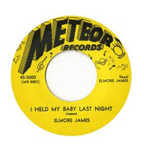
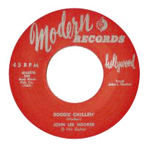 Various
Artists
Various
Artists
Various Modern/ Flair/Meteor/RPM 45’s
Ace Records (UK) www.acerecords.com
Formed in April, 1945 in Los Angeles by white businessman Jules Bihari
and his three brothers Saul, Joe and Lester, Modern Records (and its various
subsidiaries) was one of the most superior rhythm and blues and blues
indies of the postwar era. The brothers, mainly because of their streamlined
distribution system, proved very influential in the process of transforming
black rhythm ‘n’ ßblues music into rock ‘n’
roll which began to appeal to white teenagers in the mid-1950s—the
enterprising quartet had a label based in Memphis called Meteor (that
released singles by the likes of Elmore James and Sunny Blair), a regional
office in New York City, conducted numerous field trips and had numerous
contacts throughout the South. The other labels besides parent Modern,
that issued sides by John Lee Hooker (success struck right out of the
box with Hooker’s chart-topping “Boogie Chillen”), Boyd
Gilmore and the doo-wopping Cliques, were RPM and Flair. The former’s
roster included Howlin’ Wolf, Preacher Stephens, The Fox and the
enigmatic George “Mr. Blues” Jackson while Flair released
jukebox and DJ favorites by Mercy Dee, Little Johnny Jones and his Hound
Dogs, Big Duke, Ike Turner (who also was a talent scout for the label),
Shirley Gunter and the Flairs as well as Chicago’s Little Johnny
Jones and Elmore James. Under review here are 20 exact- reproduction 45’s
by all the artists mentioned above—particular gems include all three
by Elmore James and his Broom Dusters, a pair by Ike Turner ( the timely
“Cuban Get Away” and “Cubano Jump”), The Fox’s
off-the-wall two-part “The Dream,” “Gettin’ High”
by the Flairs, Preacher Stephens’ “Whoopin’ And A Hollerin’”
and Jones and his Hound Dogs with their fantastic “Dirty By The
Dozen.” Get your favorites while they last—check out the “Singles”
category at Ace’s website.—Gary von Tersch
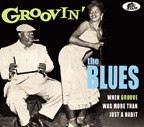 Groovin’
The Blues/Rockin’ The Groove
Groovin’
The Blues/Rockin’ The Groove
When Groove Was More Than Just A Habit
Bear Family BCD 17411/BCD 17412
Noting the commercial success of newly arisen independent labels like
Atlantic, Specialty, King, Chess and Imperial among a host of others in
the early 1950s, industry giant RCA Victor decided to enter the jukebox
and radio station friendly rhythm ‘n’ blues/blues field, hiring
A&R man Danny Kessler away from Columbia’s race label, Okeh.
Groove (with its distinctive greenish label) only survived until late
1957 and managed only one hit (Mickey and Sylvia’s crossover smash
“Love Is Strange”) but recorded a lot of great music. Conducting
sessions in both New York as well as at various Southern locations, Groove
featured a wide-ranging roster of artists from top-shelf vocal groups
like the Du Droppers (an easy rockers “That’s All I Need”
and “You’ve Been Good To Everybody” are here), a bevy
of tough-sounding female vocalists in the Ruth Brown/Lavern Baker mold
(check out Maymie Watts, Lil McKenzie, Bertice Reasing and Lillian Childs
for starters), future smooth jazz guitarist George Benson (with, unfortunately,
a pair of forgettable sides), R&B blues guitarist Roy Gaines at the
rip-roaring outset of his career (a hard-driving “Hoodoo”
is here), Sam “Highpockets” Henderson (otherwise known as
West Coast jazz legend Shorty Rogers) and raucous country blues harmonica
genius Sonny Terry—who recorded for everybody. Along with Terry,
a raft of bluesmen dominate the Groovin’ disc—from Champion
Jack Dupree, Cousin Leroy, Big Tiny Kennedy, Little Tommy Brown (with
his have-to-hear-it to-believe-it weeper “Don’t Leave Me”),
Oscar Black and Sonny Brooks—with his laid-back “Sentimental
Blues.” Also featured on various selections are top-notch, hot R&B
bandleaders like Buddy Lucas and Paul Williams and first-call session
men such as guitarist Mickey Baker—of “Love Is Strange”
fame. Three great drinking songs are scattered among the 68 tracks—Sonny
Brooks with his new concoction “Champ Ale,” Sonny Terry with
his “Juice Head Woman” and Buddy Lucas’ red-faced admission
“I Got Drunk.” Two CD’s, with extensively researched
liners by Bill Dahl, devoted to an intriguing, little known slice of R&B
history. But where’s Piano Red?—Gary von Tersch
 Chris
O’Leary
Chris
O’Leary
Gonna Die Tyrin’
American Show Place Music
2015 was a year that saw a number of impressive harmonica-led recordings.
For this writer’s money, Chris O’Leary stood at the head of
the class. With a fat tome that sometimes reminds of William Clarke, O’Leary
is an exceptionally impressive songwriter and vocalist, as well. He’s
as steeped in real life as he is in poetic painting. On the opener, Can’t
Help Yourself (“If you want to do it/ ahead and just say screw it.”)
Chris Vitarello’s guitar is fluid and stinging. O’Leary blows
crystal clear harp. 19cents a day is a glimpse into the reality of war
(“A pat on the back/HR will show you the door/when they finish screwin’
dad they’ll send junior off to war/3 years in the guard he’s
on tour number 2 when it’s someone else’s son it’s an
easy thing to do/See we appreciate your service sir, but sir you’ve
got to go … I’m sure they can help you down at the VA/where
they fly Old Glory proudly/for 19 cents a day”). Bruce Katz burns
up the B3 on this. Hook Line and Sinker has a horn vamp (Andy Stahl, tenor
sax and Chris DiFrancesco, baritone sax) that reminds of the Otis Redding/Carla
Thomas tune Tramp. The guitar work is straight out of Muscle Shoals. O’Leary’s
vocals are as strong as most anyone out there. Part Kim Wilson, part Tad
Robinson. The title cut (“There’s gonna be some killin’
… /it’s a razor thin line between righteousness and dyin’/
make your mind up quick or you’re gonna die tryin’/things
ain’t mentioned in polite conversation/one nation under god ain’t
a literal translation…”) is brilliant.
Letters From Home is a slow blues written from a marine’s perspective.
(“I’m terrified and lonesome/about a thousand miles away from
home/desert wind chills me to the bone/Mail call’s about the only
thing keeps a man sane/in this god forsaken combat zone….I need
your letters from home.” Again, Vitarello’s guitar work is
impressive. The Devil Drove to Town in a V8 Ford is a workout for everyone
on board. O’Leary’s writing, here as elsewhere on the disc,
is as impressive as the best of Springsteen or any other acknowledged
master. Emotive, cinematic. He sings, “Jesus said you got nothing
for me/So be gone and tempt me no more/The Devil jumped into his coupe/and
started up that V8 Ford.” The Machine showcases his excellent harp
work while bemoaning the drudgery of getting by. Walking Contradiction
(“throw me to the wolves and just let it all go.”) is hard
core Chicago. Harvest Time, with its piano, drum, bass, and horns is the
story of a man stealing electricity from his neighbors (“I got a
two year plan to get me off the grid.”) and doing “some illegal
agriculture when the sun goes down.” The addition of backing vocalist
Libby Cabello gives it a cross between church and festival. One More Saturday
Night speaks to the fallout from touring (“I gave you all I had
and you still walked away … the bad was pretty awful but the good
was pretty great”) and spotlights O’Leary’s powerful
harp work. Everything works. Strong vocals, a command of the language
and muscular harp work. Clearly one of the best releases of 2015. —Mark
E. Gallo
Books
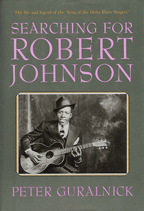 Searching
for Robert Johnson
Searching
for Robert Johnson
by Peter Guralnick
Dutton 1989
Finding Son House, One Searcher’s Story
By Richard Shade Gardner
Self-published 2015
Sadly having missed attending the four day festival honoring seminal Delta
bluesman in Rochester, NY, in August 2015, I contented myself with speeding
through Gardner’s brief book about his 1980s quest to locate House.
Only 60-some pages, excluding appendices, the book can be devoured in
a couple of hours.
A blues disc jockey at loose ends in his life, Gardner was enthralled
with House’s music, and intrigued to learn that House had lived
unrecognized for several decades quite near Gardner in Rochester, having
disappeared from the musical limelight after the 1960s folk music revival
had temporarily given him professional resurrection. House had a habit
of disappearing. A compelling guitarist and haunting and powerful singer,
he had abandoned his goal of becoming a preacher for a life instead dominated
by liquid spirits. Follower of Charley Patton, compadre of Willie Brown,
and profound influence on Robert Johnson, House made some classical recordings
in the 1920s and ‘30s, and then vanished until the ‘60s -
and then again.
After learning that House was still alive, Gardner resolved to track him,
and through diligent effort located him and his wife in Detroit. His subsequent
trek to meet the man could have been anticlimactic; in 1981, House was
no longer playing or singing and his memory was deficient. Gardner writes,
“It was as though Son just inhabited this sterile apartment and
didn’t really ‘live’ here, he was just ‘doing
time’ in the latter years of his life.” However, he still
radiated joy in speaking of the blues.
Gardner’s book, although ostensibly about House, is really more
about Gardner himself and the personal meaning of his quest. Reading it
stimulated me to re-read Guralnick’s also brief and superficially
similar book published a quarter century ago.
A noted musical journalist and historian, Guralnick was fascinated not
only by Johnson’s masterful artistry, but also by the mysterious
myths, rumors, and legends surrounding the man. Johnson died in 1938,
allegedly poisoned by the cuckolded husband of one of his many lovers;
Guralnick assiduously tackled Johnson’s life as a saga to be revered
as well as a mystery to be solved. The result is a mini-biography that
delineates the Delta bluesman’s wanderings and influences and places
him in historical context among such other blues giants as House, Patton,
Robert Jr. Lockwood, Howlin’ Wolf, and Muddy Waters. Guralnick’s
assessments of each of Johnson’s few surviving songs is worth reading
and contemplating. Whether you agree with his opinion of individual songs,
it’s hard to argue with his assertion that Robert Johnson was one
of the foremost progenitors of the blues.— Steve Daniels
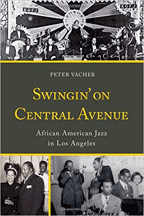 Swingin’
On Central Avenue
Swingin’
On Central Avenue
African American Jazz In Los Angeles
By Peter Vacher
Rowman & Littlefield Publishing Group www.rowman.com
From approximately 1920-1960 Central Avenue was ground zero for the African-American
community in Los Angeles, with its bustling black jazz and rhythm and
blues music scenes. Local luminaries included the likes of Eric Dolphy,
Wardell Gray, Johnny Otis (who wrote his own book about the scene titled
Upside Your Head! Rhythm and Blues On Central Avenue), Benny Carter, Charlie
Mingus, Dexter Gordon, Lionel Hampton, Charlie Parker (briefly but significantly)
and Teddy Wilson. All of whom readers of this journal have no doubt heard
of because they didn’t mind being on the road a lot and spending
time in the recording studio, whereas the jazz musicians dealt with in
this fascinating oral history project, to a man (and one woman), never
gained “international fame or achieved much more than local celebrity”
as author Peter Vacher concisely puts it in his introduction. He continues:
“Their recordings were largely low-key and, in some cases, frustratingly
few. Most stayed close to home once they had settled in Los Angeles or
its surrounding area. Only a handful ever toured Europe more than once
or moved regularly beyond California’s confines, although saxophonist
Caughey Roberts Jr. did travel to Shanghai, China in the early 1930s and
both trumpeter Andy Blakeney and drummer Monk McFay worked in Hawaii for
a significant period.” The career paths of these jazz journeymen
encompassed Southern territory dance bands, minstrel and circus shows,
cabaret and theater orchestras, swing combos and rhythm ‘n’
blues groups as well as New Orleans revivalist music. Theirs are, basically,
previously under-documented life stories for only a few were ever interviewed
(and never at this length) or with this large amount (25 pages) of accompanying
pictorial material. Their memories are also sharp—the sagas and
atmospheric detail provided, in their own words, by the likes of the fore-mentioned
Monk McFay, multi-instrumentalist “Red Mack” Morris, pianist
Chester C. Lane, keyboardist Betty Hall Jones, bassist Billy Hadnott and
trombonist “Streamline” Ewing are especially edifying. Along
the way, Vacher also takes a close look at Los Angeles’ “covenant”
housing situation, Jefferson High School (that produced more jazz musicians
and composers than any other school west of the Mississippi), the role
of the black musicians union and the comparative disregard of these gifted
artists—who lived in a world within a world of ostentatious white
nightclubs with black bands, after-hours joints and ghetto clubs that
was the result of the migration of black musicians to the West Coast after
World War II. A welcome study that goes first-person and behind-the-scenes
of a vibrant, colorful jazz community.—Gary von Tersch
Home
/ Blues Blogs /
Artist Links / Blues
Links / Videos / Store
Subscribe / Advertise
/ Back Issues
/ Contact / Staff